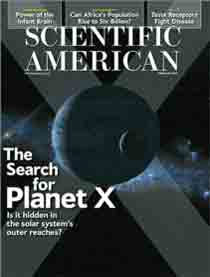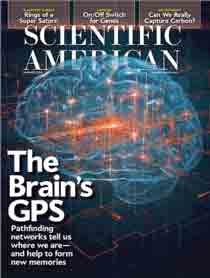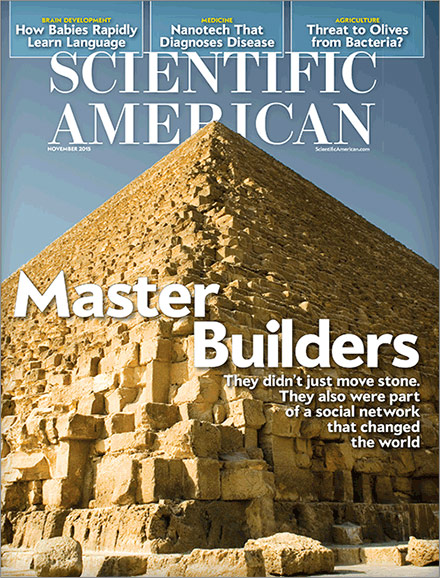February 1, 2016
Can a brain’s connectome be preserved forever?
The soul is the pattern of information that represents you—your thoughts, memories and personality—your self. There is no scientific evidence that something like soul stuff exists beyond the brain’s own hardwiring, so I was curious to visit the laboratories of 21st Century Medicine in Fontana, Calif., to see for myself an attempt to preserve a brain’s connectome—the comprehensive diagram of all neural synaptic connections.
This medical research company specializes in the cryopreservation of human organs and tissues using cryoprotectants (antifreeze). In 2009, for example, the facility’s chief research scientist Gregory M. Fahy published a paper in the peer-reviewed journal Organogenesis, documenting how his team successfully transplanted a rewarmed rabbit kidney after it had been cryoprotected and frozen to -135 degrees Celsius through the process of vitrification, “in which the liquids in a living system are converted into the glassy state at low temperatures.”
Can brains be so preserved? Fahy and his colleague Robert L. McIntyre are now developing techniques that they hope will win the Brain Preservation Technology Prize, the brainchild of neuroscientist Kenneth Hayworth (I’m on their advisory board as the advocatus diaboli). As I write this, the prize is currently valued at more than $106,000; the first 25 percent of the award will be for the complete preservation of the synaptic structure of a whole mouse brain, and the other 75 percent will go to the first team “to successfully preserve a whole large animal brain in a manner that could also be adopted for humans in a hospital or hospice setting immediately upon clinical death.” (continue reading…)
January 1, 2016
Did Homo naledi behave more like Homo homicidensis?
“Fossil First: Ancient Human Relative May Have Buried Its Dead” (Reuters). “Why Did Homo naledi Bury Its Dead?” (PBS). These are just two of the many hyped headlines that appeared last September in response to a paper purporting the discovery, in a cave in South Africa, of a new species by paleoanthropologist Lee R. Berger of the University of the. There were reasons for skepticism from the get-go.
The age of the fossils is undetermined, and it is not yet known where in the hominin lineage the fossils fit. Their hands, wrists and feet are similar to small modern humans, and their brain volume is closer to that of the small-brained australopithecines, like Lucy. Researchers are debating whether these and other traits constitute a new species or a variation on an existing species. Instead of publishing in Science or Nature, the prestigious journals in which major new fossil human finds are typically announced, the authors unveiled their discovery in eLIFE, an open-access online journal that fast-tracks the peer-review process. And instead of meticulously sorting through the 1,550 fossils (belonging to at least 15 individuals) for many years, as is common in paleoanthropology, the analysis was published a mere year and a half after their discovery in November 2013 and March 2014.*
What triggered my skepticism, however, was the scientists’ conjecture that the site represents the earliest example of “deliberate body disposal,” which, as the media read between the lines, implies an intentional burial procedure. This, they concluded was the likeliest explanation compared with four other hypotheses. (continue reading…)
December 1, 2015
Or why climate skeptics are wrong
At some point in the history of all scientific theories, only a minority of scientists—or even just one—supported them, before evidence accumulated to the point of general acceptance. The Copernican model, germ theory, the vaccination principle, evolutionary theory, plate tectonics and the big bang theory were all once heretical ideas that became consensus science. How did this happen?
An answer may be found in what 19th-century philosopher of science William Whewell called a “consilience of inductions.” For a theory to be accepted, Whewell argued, it must be based on more than one induction—or a single generalization drawn from specific facts. It must have multiple inductions that converge on one another, independently but in conjunction. “Accordingly the cases in which inductions from classes of facts altogether different have thus jumped together,” he wrote in his 1840 book The Philosophy of the Inductive Sciences, “belong only to the best established theories which the history of science contains.” Call it a “convergence of evidence.”
Consensus science is a phrase often heard today in conjunction with anthropogenic global warming (AGW). Is there a consensus on AGW? There is. The tens of thousands of scientists who belong to the American Association for the Advancement of Science, the American Chemical Society, the American Geophysical Union, the American Medical Association, the American Meteorological Society, the American Physical Society, the Geological Society of America, the U.S. National Academy of Sciences and, most notably, the Intergovernmental Panel on Climate Change all concur that AGW is in fact real. Why? (continue reading…)
November 1, 2015
Do we perceive reality as it is?
One of the deepest problems in epistemology is how we know the nature of reality. Over the millennia philosophers have offered many theories, from solipsism (only one’s mind is known to exist) to the theory that natural selection shaped our senses to give us an accurate, or veridical, model of the world. Now a new theory by University of California, Irvine, cognitive scientist Donald Hoffman is garnering attention. (Google his scholarly papers and TED talk with more than 1.4 million views.) Grounded in evolutionary psychology, it is called the Interface Theory of Perception (ITP) and argues that percepts act as a species-specific user interface that directs behavior toward survival and reproduction, not truth.
Hoffman’s computer analogy is that physical space is like the desktop and that objects in it are like desktop icons, which are produced by the graphical user interface (GUI). Our senses, he says, form a biological user interface—a gooey GUI—between our brain and the outside world, transducing physical stimuli such as photons of light into neural impulses processed by the visual cortex as things in the environment. GUIs are useful because you don’t need to know what is inside computers and brains. You just need to know how to interact with the interface well enough to accomplish your task. Adaptive function, not veridical perception, is what is important. (continue reading…)
October 1, 2015
Discerning science from pseudoscience
Newton was wrong. Einstein was wrong. Black holes do not exist. The big bang never happened. Dark energy and dark matter are unsubstantiated conjectures. Stars are electrically charged plasma masses. Venus was once a comet. The massive Valles Marineris canyon on Mars was carved out in a few minutes by a giant electric arc sweeping across the Red Planet. The “thunderbolt” icons found in ancient art and petroglyphs are not the iconography of imagined gods but realistic representations of spectacular electrical activity in space.
These are just a few of the things I learned at the Electric Universe conference (EU2015) in June in Phoenix. The Electric Universe community is a loose confederation of people who, according to the host organization’s website, believe that “a new way of seeing the physical universe is emerging. The new vantage point emphasizes the role of electricity in space and shows the negligible contribution of gravity in cosmic events.” This includes everything from comets, moons and planets to stars, galaxies and galactic clusters. (continue reading…)






